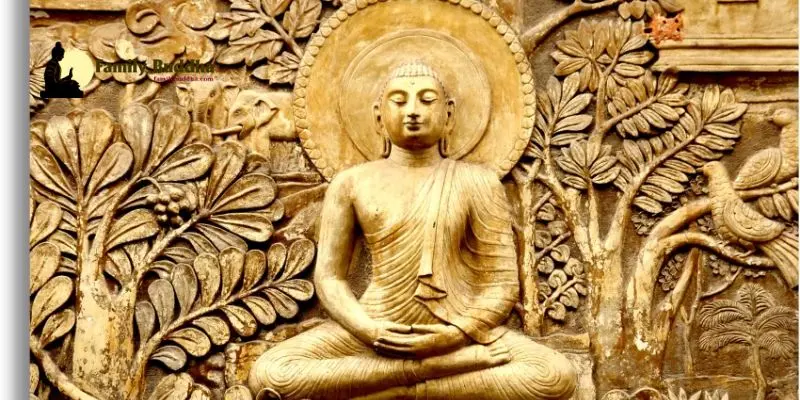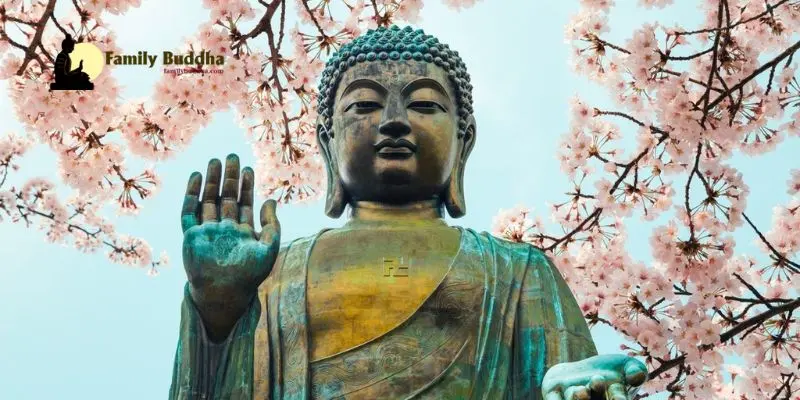Rooted in the teachings of Siddhartha Gautama, known as the Buddha, Buddhism offers unique insights into the qualities and responsibilities inherent in effective leadership. Unlike conventional leadership paradigms that often emphasize power and authority, Buddhist leadership espouses a holistic approach grounded in compassion, wisdom, and selflessness. Let’s discover about Leadership in Buddhism in the article below from Familybuddha.com.
The Buddha Was Not an Ordinary Leader

An Extraordinary Journey
The Buddha, also known as Siddhartha Gautama, was born into a wealthy family in ancient India. As a young man, he was sheltered from the harsh realities of life, living a life of luxury and privilege. However, his life took an extraordinary turn when he ventured out of the palace and encountered the harsh realities of human existence – suffering, sickness, old age, and death.
This experience profoundly impacted him and sparked an intense spiritual quest that led him to renounce his princely life and embark on a journey of self-discovery. After years of intense meditation and inner exploration, he attained enlightenment, becoming the Buddha – the “Awakened One.”
Beyond a Spiritual Leader
While the Buddha is primarily revered as a spiritual leader and the founder of Buddhism, his life and teachings offer invaluable leadership lessons that extend far beyond the realm of religion. His journey exemplifies the qualities of a truly exceptional leader – one who challenges the status quo, embraces change, and inspires others to embark on a path of personal growth and transformation.
The Buddha’s leadership was not rooted in hierarchical structures or authoritarian principles but rather in his ability to guide and inspire through wisdom, compassion, and a deep understanding of the human condition.
But What Made His Leadership Special?

The Power of Example
One of the most remarkable aspects of the Buddha’s leadership was his ability to lead by example. He did not merely preach or dictate; instead, he embodied the very principles he taught. His life was a living manifestation of the virtues he espoused, such as mindfulness, compassion, and equanimity.
Through his actions and way of being, the Buddha demonstrated the transformative power of his teachings, inspiring others to follow in his footsteps and embrace a life of inner peace, wisdom, and personal growth.
Compassionate Guidance
The Buddha’s leadership style was characterized by an unwavering commitment to compassion and a deep concern for the well-being of others. He recognized that true leadership is not about wielding power or authority but about serving and guiding others toward their highest potential.
His teachings were rooted in the recognition that suffering is an inherent part of the human experience and that the path to liberation lies in understanding and transcending this suffering. Through his compassionate guidance, the Buddha offered a framework for individuals to cultivate inner strength, resilience, and a profound sense of interconnectedness with all beings.
Inclusivity and Accessibility
Another remarkable aspect of the Buddha’s leadership was his inclusivity and accessibility. Unlike many religious and spiritual leaders of his time, the Buddha did not discriminate based on social status, gender, or caste. His teachings were open to all, regardless of their background or circumstances.
This inclusive approach allowed his message to resonate with people from all walks of life, transcending cultural and social barriers. The Buddha recognized that the universal truths he taught were not exclusive to any particular group but applied to all beings seeking liberation from suffering.
The Buddha’s Purpose, Mission, and Vision

The Purpose: Alleviating Suffering
At the core of the Buddha’s teachings was the recognition that suffering is an inherent part of the human experience. His purpose was to provide a pathway for individuals to alleviate their suffering and attain liberation – a state of profound inner peace and enlightenment.
This purpose was not limited to personal transformation but extended to the alleviation of suffering for all beings. The Buddha’s compassionate teachings encouraged individuals to cultivate a deep sense of interconnectedness and to work toward the betterment of all sentient beings.
The Mission: Teaching the Dharma
The Buddha’s mission was to share the knowledge and wisdom he had gained through his enlightenment experience, known as the Dharma. The Dharma encompassed a vast body of teachings that addressed various aspects of human existence, including the nature of reality, the cycle of rebirth, and the path to liberation.
Through his mission of teaching the Dharma, the Buddha sought to guide individuals toward a deeper understanding of themselves and the world around them. He recognized that true transformation could only occur when individuals gained insight into the root causes of their suffering and the interconnectedness of all phenomena.
The Vision: A Path to Enlightenment
The Buddha’s vision extended far beyond his lifetime. He envisioned a world where individuals could awaken to their full potential and transcend the cycle of suffering. This vision was not limited to a specific group or culture but encompassed all beings who were willing to embark on the journey toward enlightenment.
Through his teachings and the establishment of the monastic order (Sangha), the Buddha laid the foundations for a lasting legacy – a path that would continue to guide and inspire generations to come. His vision was one of universal compassion, wisdom, and the recognition that true liberation is possible for all who are willing to embrace the teachings and walk the path he had illuminated.
The Four Truths of Your Leadership

#1: Have a Purpose
Just as the Buddha was driven by the purpose of alleviating suffering, effective leaders must have a clearly defined purpose that guides their actions and decisions. This purpose should be rooted in a deep understanding of the needs and aspirations of those they seek to serve.
Leaders with a strong sense of purpose can navigate challenges and obstacles with resilience and determination, as they are anchored in a higher calling that transcends personal ambition or gain.
“The mind is everything. What you think, you become.” – The Buddha
To cultivate a sense of purpose as a leader, one must engage in self-reflection and introspection, seeking to understand their values, beliefs, and the impact they wish to have on the world. By aligning their actions with a higher purpose, leaders can inspire and motivate others to join them in creating positive change.
#2: Have a Mission
Building upon a clear purpose, effective leaders must also define a mission – a specific set of goals and objectives that guide their actions and serve as a roadmap for achieving their purpose. Just as the Buddha’s mission was to share the Dharma and teach the path to enlightenment, leaders must identify the specific steps and initiatives that will bring their purpose to fruition.
A well-defined mission provides clarity and direction, enabling leaders to prioritize their efforts, allocate resources effectively, and measure progress toward their goals.
“We are what we think. All that we are arises from our thoughts. With our thoughts, we make the world.” – The Buddha
To develop a compelling mission, leaders must engage in strategic planning, gathering input from stakeholders, and considering the unique challenges and opportunities that lie ahead. By articulating a clear mission, leaders can align their teams, foster collaboration, and ensure that everyone is working towards a common vision.
#3: Have a Vision
While purpose and mission define the “why” and the “what” of leadership, vision provides the “where” – a clear picture of the desired future state that leaders aspire to create. The Buddha’s vision was one of universal enlightenment, where all beings could transcend suffering and attain inner peace.
Effective leaders must cultivate a compelling vision that inspires and motivates others to join them on their journey. A well-articulated vision creates a shared sense of direction and purpose, fostering alignment and commitment among team members.
“The way is not in the sky. The way is in the heart.” – The Buddha
To develop a powerful vision, leaders must tap into their creativity, imagination, and ability to think big. They must also be attuned to the needs and aspirations of those they serve, ensuring that their vision resonates and addresses the challenges and opportunities of the present and future.
#4: Set the Tone
The Buddha’s leadership was not just about imparting knowledge and wisdom; it was also about embodying the very principles he taught. He led by example, living a life of mindfulness, compassion, and equanimity, setting the tone for those who followed his path.
Effective leaders must also set the tone for their teams and organizations, leading by example and modeling the behaviors and values they wish to cultivate. This includes:
- Integrity: Demonstrating unwavering ethical principles and consistency between words and actions.
- Emotional Intelligence: Being self-aware, empathetic, and able to manage one’s emotions and those of others.
- Humility: Recognizing that leadership is a privilege and an opportunity to serve, not a position of power or superiority.
- Resilience: Maintaining composure and perseverance in the face of adversity and challenges.
By setting the tone through their actions and way of being, leaders can create a positive and inspiring culture that fosters trust, respect, and a shared commitment to excellence.
“In the end, only three things matter: how much you loved, how gently you lived, and how gracefully you let go of things not meant for you.” – The Buddha
#5: Be Mindful
One of the central teachings of the Buddha was the practice of mindfulness – the ability to be fully present in the moment, with a heightened awareness and acceptance of one’s thoughts, emotions, and surroundings. This practice was not only a means of personal growth and liberation but also a powerful tool for effective leadership.
Leaders who cultivate mindfulness are better able to make informed decisions, manage stress, and communicate with clarity and empathy. By being present and attentive, they can create space for reflection, creativity, and innovation, fostering a culture of openness and learning within their teams.
“To understand everything is to forgive everything.” – The Buddha
Mindful leaders also have a deeper understanding of themselves and others, enabling them to build strong relationships, resolve conflicts, and inspire trust and collaboration. By practicing mindfulness in their daily interactions and decision-making, leaders can create a positive and supportive work environment where individuals feel valued, heard, and empowered.
By incorporating mindfulness practices such as meditation, deep breathing, or reflective journaling into their routine, leaders can enhance their self-awareness, emotional intelligence, and resilience, enabling them to navigate challenges with grace and wisdom.
What Is the Takeaway?
The leadership lessons of the Buddha offer timeless wisdom and guidance for leaders seeking to make a positive impact in the world. By embodying the principles of purpose, mission, vision, setting the tone, and mindfulness, leaders can cultivate a culture of compassion, wisdom, and excellence within their organizations.
Just as the Buddha envisioned a world free from suffering and ignorance, leaders can aspire to create environments where individuals can thrive, grow, and realize their full potential. By aligning their actions with a higher purpose, leading with integrity and humility, and fostering a culture of mindfulness and collaboration, leaders can inspire and empower others to join them on the path toward shared success and fulfillment.
In a world marked by uncertainty, complexity, and rapid change, the leadership lessons of the Buddha remind us of the power of compassion, wisdom, and inner transformation. By embracing these timeless teachings and integrating them into our leadership practice, we can create a more harmonious, resilient, and compassionate world for all beings.
Conclusion
In conclusion, Leadership in Buddhism offers profound insights and guidance for leaders seeking to make a meaningful difference in the world. By embodying the principles of purpose, mission, vision, setting the tone, and mindfulness, leaders can cultivate a culture of compassion, wisdom, and excellence within their organizations.
Just as the Buddha’s teachings continue to inspire and guide millions of people around the world, so too can his example serve as a beacon of light for leaders navigating the complexities of the modern world. By aligning their actions with a higher purpose, leading with integrity and humility, and fostering a culture of mindfulness and collaboration, leaders can create lasting impact and positive change in their communities and beyond.
May we all strive to embody the timeless wisdom of the Buddha in our leadership journey, cultivating compassion, wisdom, and enlightenment for the benefit of all beings.










